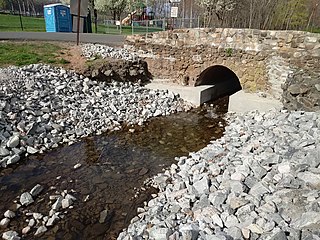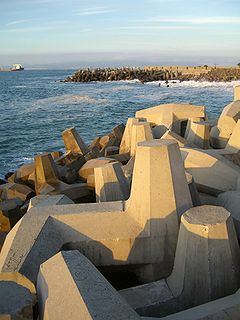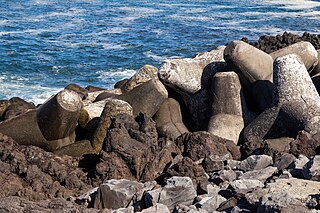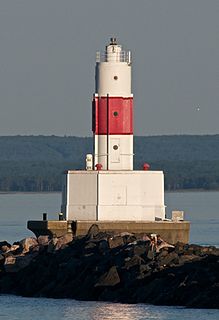
An akmon is a multi-ton concrete block used for breakwater and seawall armouring. [1] It was originally designed in the Netherlands in the 1960s, as an improvement on the tetrapod. [2]

An akmon is a multi-ton concrete block used for breakwater and seawall armouring. [1] It was originally designed in the Netherlands in the 1960s, as an improvement on the tetrapod. [2]

A groyne is a rigid hydraulic structure built perpendicularly from an ocean shore or a river bank, interrupting water flow and limiting the movement of sediment. It is usually made out of wood, concrete, or stone. In the ocean, groynes create beaches, prevent beach erosion caused by longshore drift where this is the dominant process and facilitate beach nourishment. There is also often cross-shore movement which if longer than the groyne will limit its effectiveness. In a river, groynes slow down the process of erosion and prevent ice-jamming, which in turn aids navigation.

A jetty is a structure that projects from land out into water. A jetty may serve as a breakwater, as a walkway, or both; or, in pairs, as a means of constricting a channel. The term derives from the French word jetée, "thrown", signifying something thrown out.

A breakwater is a permanent structure constructed at a coastal area to protect against tides, currents, waves, and storm surges. Part of a coastal management system, breakwaters are installed to minimize erosion, and to protect anchorages, helping isolate vessels within them from marine hazards such as prop washes and wind-driven waves. A breakwater, also known in some contexts as a jetty, may be connected to land or freestanding, and may contain a walkway or road for vehicle access.

The Phoenix breakwaters were a set of reinforced concrete caissons built as part of the artificial Mulberry harbours that were assembled as part of the preparations for the Normandy landings during World War II. They were constructed by civil engineering contractors around the coast of Britain. They were collected at Dungeness and Selsey, and then towed by tugboats across the English Channel and sunk to form the Mulberry harbour breakwaters replacing the initial "Gooseberry" block ships. Caissons were added in the autumn of 1944 to reinforce the existing structure to cope with the harbour continuing in use longer than planned.

Revetments in stream restoration, river engineering or coastal engineering, are structures placed on banks or cliffs in such a way as to absorb the energy of incoming water. In military engineering they are sloped structures formed to secure an area from artillery, bombing, or stored explosives. River or coastal revetments are usually built to preserve the existing uses of the shoreline and to protect the slope, as a defense against erosion.

Riprap, also known as rip rap, rip-rap, shot rock, rock armour or rubble, is human-placed rock or other material used to protect shoreline structures against scour and water, wave, or ice erosion. Ripraps are used to armor shorelines, streambeds, bridge abutments, foundational infrastructure supports and other shoreline structures against erosion. Common rock types used include granite and modular concrete blocks. Rubble from building and paving demolition is sometimes used, as well as specifically designed structures called tetrapods.

Trial Bay Gaol is a heritage-listed former public works prison and internment camp at Cardwell Street, Arakoon, Kempsey Shire, New South Wales, Australia. The property is owned by the NSW National Parks and Wildlife Service. It was added to the New South Wales State Heritage Register on 14 May 2010.

A dolos is a wave-dissipating concrete block used in great numbers as a form of coastal management. Weighing up to 80 tonnes, dolos are used to build revetments for protection against the erosive force of waves from a body of water. The dolos was invented in 1963, and was first deployed in 1964 on the breakwater of East London, a South African port city.

Accropode blocks are wave-dissipating concrete blocks designed to resist the action of waves on breakwaters and coastal structures.
Hard engineering involves the construction of hydraulic structures to protect coasts from erosion. Such structures include seawalls, gabions, breakwaters, groynes and tetrapods.

A Tetrapod is a form of wave-dissipating concrete block used to prevent erosion caused by weather and longshore drift, primarily to enforce coastal structures such as seawalls and breakwaters. Tetrapods are made of concrete, and use a tetrahedral shape to dissipate the force of incoming waves by allowing water to flow around rather than against them, and to reduce displacement by interlocking.

An Xbloc is a wave-dissipating concrete block designed to protect shores, harbour walls, seawalls, breakwaters and other coastal structures from the direct impact of incoming waves. The Xbloc model was designed and developed by the Dutch firm Delta Marine Consultants, now called BAM Infraconsult, a subsidiary of the Royal BAM Group in 2001 and has been subjected to extensive research by several universities.
Beach evolution occurs at the shoreline where sea, lake or river water is eroding the land. Beaches exist where sand accumulated from centuries-old, recurrent processes that erode rocky and sedimentary material into sand deposits. River deltas deposit silt from upriver, accreting at the river's outlet to extend lake or ocean shorelines. Catastrophic events such as tsunamis, hurricanes, and storm surges accelerate beach erosion.

The Manistique East Breakwater Light is a lighthouse is located in the harbor of Manistique, Michigan. It was listed on the National Register of Historic Places in 2005.
Hudson's equation, also known as Hudson formula, is an equation used by coastal engineers to calculate the minimum size of riprap (armourstone) required to provide satisfactory stability characteristics for rubble structures such as breakwaters under attack from storm wave conditions.

KOLOS is a wave-dissipating concrete block intended to protect coastal structures like seawalls and breakwaters from the ocean waves. These blocks were developed in India and were first adopted for the breakwaters of the Krishnapatnam Port along the East coast of India.

The Presque Isle Harbor Breakwater Light is a lighthouse located on the breakwater at northeast side of Presque Isle Harbor in Marquette, Michigan. It was listed on the National Register of Historic Places in 2016.

The St Elmo Bridge is a single-span arched truss steel footbridge leading from the foreshore of Fort Saint Elmo in Valletta, Malta, to the breakwater at the entrance of the Grand Harbour. It was constructed in 2011–12 to designs of the Spanish architects Arenas & Asociados. The bridge stands on the site of an earlier bridge which had been built in 1906 and which was destroyed during World War II in 1941. The original bridge had a similar design to the present one, but it had two spans instead of one.

A block-setting crane is a form of crane. They were used for installing the large stone blocks used to build breakwaters, moles and stone piers.

A wave-dissipating concrete block is a naturally or manually interlocking concrete structure designed and employed to minimize the effects of wave action upon shores and shoreline structures, such as quays and jettys.